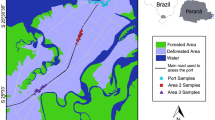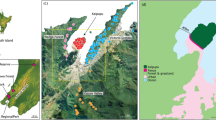Abstract
The detrimental effects of the introduced ship rat on bird species on the Lavezzi Mediterranean archipelago has led to the decision to eradicate the rodent from the main island, Lavezzu (73 ha), as well as from several neighbouring islets. A genetic study using eight microsatellite markers has revealed some of the dynamics of this rat population. First, it has been shown that the rat population was genetically stable (no departure from Hardy-Weinberg equilibrium and no linkage disequilibrium) and as suggested by paleontological data, established for a long time. This information is encouraging in term of viability of the eradication campaign in the long term, even if rare immigration events cannot be excluded. Second, this study shows that rats are likely to swim between the main island and the islets quite regularly since no clear genetic differentiation has been detected between them. This result is quite surprising since the ship rat is not known for its swimming abilities. Third, a cryptic genetic structure has been detected on the main island, with the north peninsula differentiated from the rest. This result correlates the observation of particular predation behaviours only observed in this part of the island. Finally, evolutionary hypotheses (e.g., dispersal limitation, emergence of family groups, local adaptation) are discussed to explain the genetic patterns observed and the population functioning inferred. These results should be of particular interest to wildlife managers concerned with rat eradications, and also provide clear insights into the study of other biological invasions.



Similar content being viewed by others
References
Abdelkrim J, Pascal M, Calmet C, Samadi S (2005a) Importance of assessing population genetic structure prior to eradication of invasive species: Examples from insular Rattus norvegicus populations. Conserv Biol 19:1509–1518
Abdelkrim J, Pascal M, Samadi S (2005b) Island colonization and founder effects: the invasion of the Guadeloupe islands by ship rats (Rattus rattus). Mol Ecol 14:2923–2931
Abdelkrim J, Pascal M, Samadi S (2007) Establishing causes of eradication failure based on genetics: case study of ship rat eradication in Ste. Anne archipelago. Conserv Biol 21:719–730
Anderson PK (1970) Ecological structure and gene flow in small mammals. Symp Zool Soc Lon 26:283–295
Atkinson IAE (1985) The spread of commensal species of Rattus to oceanic islands and their effects on island avifaunas. ICBP Tech Publ 3:35–79
Belkhir K, Castric V, Bonhomme F (2002) IDENTIX, a software for relatedness in a population using permutation methods. Mol Ecol Notes 2:611–614
Buckner CH (1957) Population studies on small mammmals of South Eastern Manitoba. J Mammal 38:87–97
Calmet C, Pascal M, Samadi S (2001) Is it worth eradicating the invasive pest Rattus norvegicus from Molène archipelago? genetic structure as a decision-making tool. Biodivers Conserv 10:911–928
Cheylan G (1988) Les adaptations écologiques de Rattus rattus à la survie dans les îlots méditerranéens (Provence et Corse). Bulletin d’Ecologie 19:417–426
Cornuet JM, Piry S, Luikart G, Estoup A, Salignac M (1999) New methods employing multilocus genotypes to select or exclude populations as origins of individuals. Genetics 153:1989–2000
Courchamp F, Chapuis J-L, Pascal M (2003) Mammal invaders on islands: impact, control and control impact. Biol Rev 78:347–383
Dieringer D, Schlötterer C (2002) Microsatellite analyser (MSA): a platform independent analysis tool for large data set. Mol Ecol Notes 3:167–169
Granjon L, Cheylan G (1989) Le sort de rats noirs (Rattus rattus) introduits sur une île, révélé par radio-tracking. C R Acad Sci Paris 571–575.
Granjon L, Cheylan G (1990) Adaptations comportementales des rats noirs Rattus rattus des îles ouest-méditerranéennes. Vie Milieu 40:189–195
Guo SW, Thompson EA (1992) Performing the exact test of Hardy-Weinberg proportion for multiple alleles. Biometrics 48:361–372
Hamilton WD (1964) The genetical evolution of social behaviour I & II. J Theor Biol 7:1–52
Howald G, Donlan CJ, Galvan JP et al (2007) Invasive rodent eradication on islands. Conserv Biol 21:1258–1268
Jacob HJ, Brown DM, Bunker RK et al (1995) A genetic linkage map of the laboratory rat, Rattus norvegicus. Nat Genet 9:63–69
Lidicker WZ (1975) The role of dispersal in the demography of small mammals. In: Golley FB, Petrusewicz K, Ryszkowski L (eds) Small mammals: their productivity and population dynamics. Cambridge University Press, pp 103–134
Lorvelec O, Pascal M (2005) French alien mammal eradication attempts and their consequences on the native fauna and flora. Biol Inv 7:135–140
Mathieu E, Autem M, Roux M, Bonhomme F (1990) Epreuves de validation dans l’analyse de structures génétiques multivariées: comment tester l’équilibre panmictique? Revue de Statistique Appliquée 38:47–66
Moors PJ, Atkinson IAE (1984) Predation on seabirds by introduced animals, and factors affecting its severity. In: Croxall JP, Evans PGH, Schreiber RW (eds) Status and conservation of the world’s seabirds. ICBP Technical Publication, pp 667–690
Pascal M, Chapuis JL (2000) Éradication de mammifères introduits en milieux insulaires: questions préalables et mise en application. Revue d’Ecologie (Terre & Vie) 85–104
Pascal M, Cosson JF, Bioret F, Yésou P, Siorat S (1996) Réflexion sur le bien-fondé de restaurer une certaine biodiversité de milieux insulaires par l’éradication d’espèces exogènes. Cas de certains mammifères d’îles de Bretagne (France). Vie et milieu 46:345–354
Pascal M, Lorvelec O, Bretagnolle V, Culioli JM (2008) Improving the breeding success of a colonial seabird facing rat predation: a cost-benefit comparison between eradication and control. Endanger Species Res 4 (in press)
Piry S, Alapetite A, Cornuet JM et al (2004) GeneClass2: a software for genetic assignment and first generation migrants detection. J Hered 95:536–539
Pritchard JK, Stephens M, Donnelly P (2000) Inference of population structure using multilocus genotype data. Genetics 155:945–959
Rannala B, Mountain JL (1997) Detecting immigration by using multilocus genotypes. Proc Natl Acad Sci USA 94:9197–9201
Raymond M, Rousset F (1995) GENEPOP (version 1.2): population genetics software for exact test and ecumenicism. J Hered 86:248–249
Rice WR (1989) Analizing tables of statistical tests. Evolution 43:223–225
Russell JC, Towns DR, Anderson SH, Clout MN (2005) Intercepting the first rat ashore. Nature 437:1107
Sax DF, Stachowicz JJ, Brown JH et al (2007) Ecological and evolutionary insights from species invasions. Trends Ecol Evol 22:465–471
Thibault JC (1995) Effect of predation by the Black rat Rattus rattus on the breeding success of Cory’s shearwater Calonectris diomedea in Corsica. Marine Ornithol 23:1–10
Thibault JC, Granjon L, Auffray JC, Cheylan G (1997) Cory’s shearwater. J Birds Palearctic 1:75–98
Vigne JD, Granjon L, Auffray JC, Cheylan G (1994) Les micromammifères. In: L’ile Lavezzi, Hommes, animaux, archéologie et marginalité (Bonifacio, Corse, XIIeme-XIX siècles), pp 133–154
Vigne JD, Valladas H (1996) Small mammal fossil assemblages as indicators of environmental change in Northern Corsica during the last 2500 years. J Archeol Sci 23:199–215
Wanless RM, Angel A, Cuthbert RJ, Hilton GM, Ryan PG (2007) Can predation by invasive mice drive seabird extinctions? Biol Lett 3:241–244
Warham J (1996) The behaviour, population biology and physiology of the petrels. Academic Press, London
Weir BS, Cockerham CC (1984) Estimating F-statistics for the analysis of population structure. Evolution 38:1358–1370
Acknowledgements
The authors would like to acknowledge Daniel Simberloff and James Russell for their helpful comments at different stages of this work, as well as Daniel White for the improvement of English in the initial manuscript and two anonymous reviewer for their highly beneficial remarks. The eradication operation was financially supported by the Office de l’Environnement de la Corse through a contract with Institut National de la Recherche Agronomique. The genetic work was supported by a Ph.D. grant to J.A. from the Conservatoire du Littoral et des Rivages Lacustres and was conducted at the Service de Systématique Moléculaire (IFR 101—CNRS) of the Natural History Museum of Paris. We thank the rangers of the Groupement Atlantique des Brigades Mobiles d’Intervention de l’Office National de la Chasse et de la Faune Sauvage and the staff of the International Marine Park of Bonifacio Strait who actively participated to the rat eradication operations.
Author information
Authors and Affiliations
Corresponding author
Rights and permissions
About this article
Cite this article
Abdelkrim, J., Pascal, M. & Samadi, S. Genetic structure and functioning of alien ship rat populations from a Corsican micro-insular complex. Biol Invasions 11, 473–482 (2009). https://doi.org/10.1007/s10530-008-9263-9
Received:
Accepted:
Published:
Issue Date:
DOI: https://doi.org/10.1007/s10530-008-9263-9




